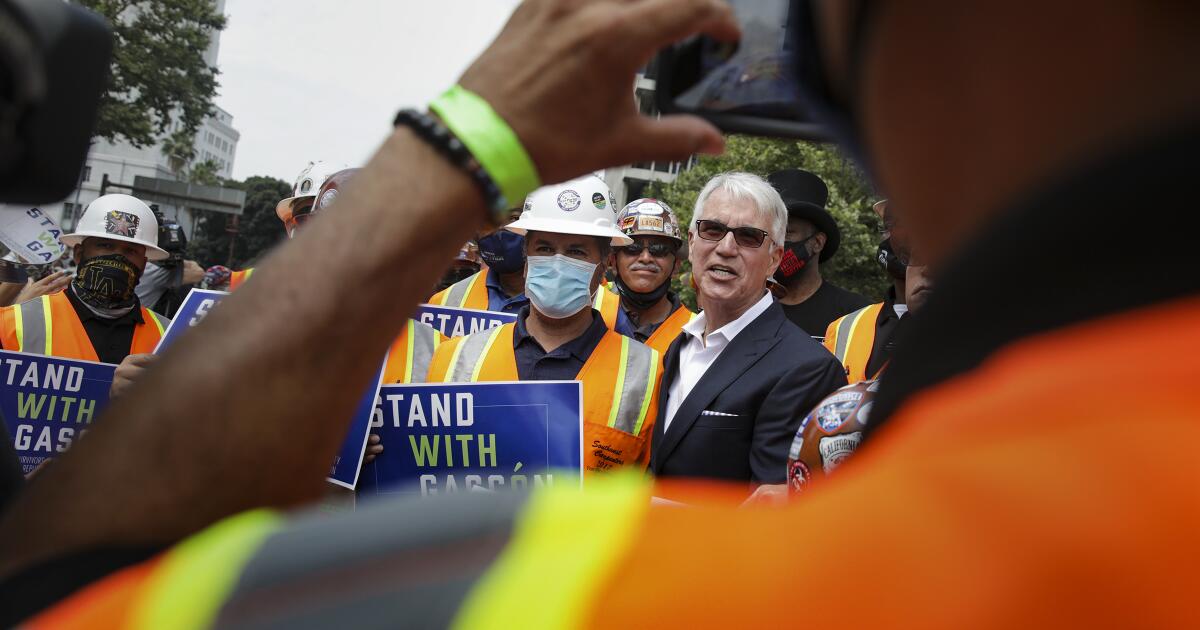Seattle mayor concedes reelection fight to progressive activist
SEATTLE — First-term Seattle Mayor Bruce Harrell conceded his reelection fight to progressive activist Katie Wilson on Thursday, handing another victory to leftist Democrats around the country frustrated with unaffordability, homelessness, public safety and the actions of President Trump’s administration.
Harrell, a centrist Democrat who previously served three terms on the City Council, led in early results. But Washington conducts all-mail elections, with ballots postmarked by Election Day. Later-arriving votes, which historically trend more liberal, broke heavily in Wilson’s favor, adding to a progressive shift to the left nationally.
In a concession speech at City Hall on Thursday afternoon, Harrell said he had congratulated Wilson in a “delightful” call.
“I feel very good about the future of this country and this city still,” he said.
Wilson, 43, is a democratic socialist who has never held elected office. She told a news conference later Thursday that it was hard for her to believe she had been elected mayor, considering that at the beginning of this year she had no intention of running, and she acknowledged concerns about her lack of experience: “No one saw this coming.”
But she also spoke to the resonance of her volunteer-driven campaign among voters concerned about affordability and public safety in a city where the cost of living has soared as Amazon and other tech companies proliferated. Universal child care, better mass transit, better public safety and stable, affordable housing are among her priorities, and she said she would take office with a strong mandate to pursue them, though she acknowledged the city also faces a significant budget shortfall.
Wilson called herself a coalition builder and community organizer, and said she would also work with those who questioned her qualifications to lead a city with more than 13,000 employees and a budget of nearly $9 billion: “This is your city too.”
“When I say this is your city, that means you have a right to be here and to live a dignified life — whatever your background, whatever your income,” Wilson said. “But it also means that we all have a collective responsibility for this city and for each other. … We cannot tackle the major challenges facing our city unless we do it together.”
She will be working with a relatively new City Council: Only two of the seven council members have served more than one term.
Harrell was elected mayor in 2021 following the chaos of the COVID-19 pandemic and racial justice protests over George Floyd’s murder by Minneapolis police. With crime falling, more police being hired, less visible drug use and many homeless encampments removed from city parks, the business-backed Harrell once seemed likely to cruise to reelection.
But Trump’s return to office — and his efforts to send in federal agents or cut funding for blue cities — helped reawaken Seattle’s progressive voters. The lesser-known Wilson, a democratic socialist, ran a campaign that echoed some of the themes of progressive mayoral candidate Zohran Mamdani in New York. She trounced Harrell by nearly 10 percentage points in the August primary and quickly became favored to win the mayor’s office.
Wilson studied at an Oxford University college in England but did not graduate. She founded the small nonprofit Transit Riders Union in 2011 and has led campaigns for better public transportation, higher minimum wages, stronger renter protections and more affordable housing. She herself is a renter, living in a one-bedroom apartment in the city’s Capitol Hill neighborhood, and says that has shaped her understanding of Seattle’s affordability crisis.
Wilson criticized Harrell as doing too little to provide more shelter and said his encampment sweeps have been cosmetic, merely pushing unhoused people around the city. Wilson also painted him as a City Hall fixture who bore responsibility for the status quo.
Harrell, 67, played on the Rose Bowl champion University of Washington football team in 1978 before going to law school. His father, who was Black, came to Seattle from the segregated Jim Crow South, and his mother, a Japanese American, was incarcerated at an internment camp in Minidoka, Idaho, during World War II after officials seized her family’s Seattle flower shop — experiences that fostered his understanding of the importance of civil rights and inclusivity.
Both candidates touted plans for affordable housing, combating crime and attempting to Trump-proof the city, which receives about $150 million a year in federal funding. Both want to protect Seattle’s sanctuary city status.
Wilson has proposed a city-level capital gains tax to help offset federal funding the city might lose and to pay for housing. Harrell says that idea is ineffective because a city capital gains tax could easily be avoided by those who would be required to pay it.
Johnson writes for the Associated Press.



